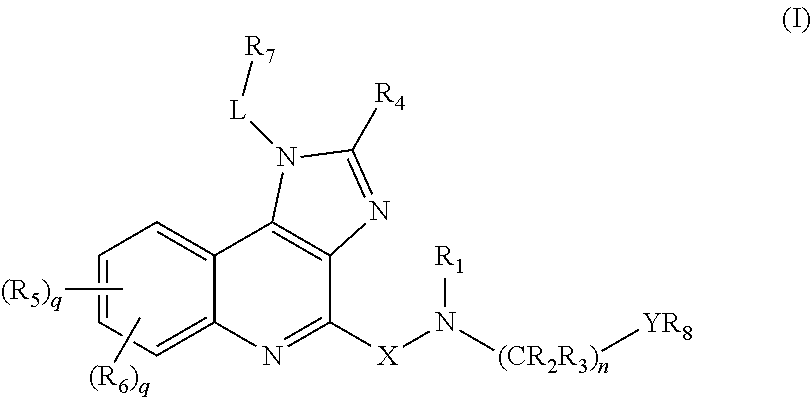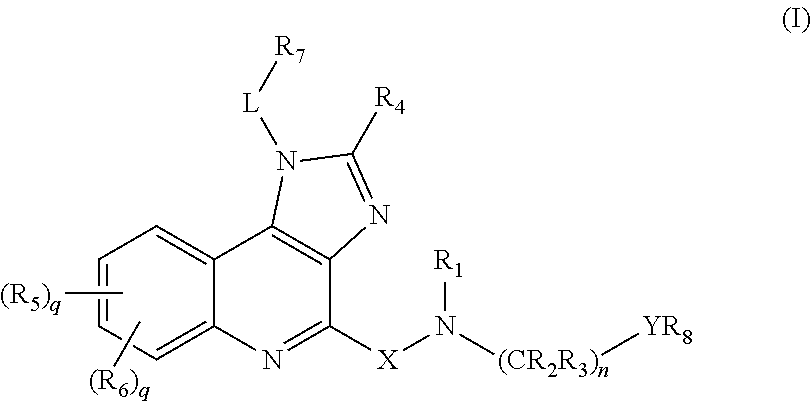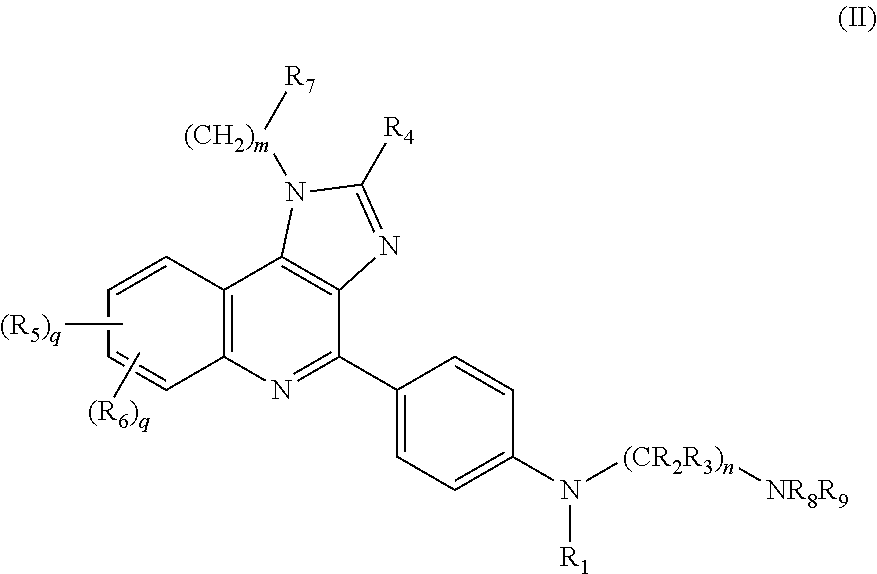Novel imidazole quinoline-based immune system modulators
a technology of immune system and imidazole, applied in the field of immunology, can solve the problems of protective or adverse physiologic outcomes of the host, and achieve the effect of altering tlr-mediated immunostimulatory signaling
- Summary
- Abstract
- Description
- Claims
- Application Information
AI Technical Summary
Benefits of technology
Problems solved by technology
Method used
Image
Examples
example 1
Compound 3 was Prepared by Using Procedures Below
[0537]
[0538]A mixture of 2,4-quinolinediol (20 gm, 0.124 moles) in acetic acid (120 mL) was stirred as concentrated nitric acid (32 mL) was added in a single portion. A thick mass resulted. This was heated in an oil bath set at 105° C. After a few minutes the mass liquefied allowing the mixture to be stirred. After a clear brown solution formed, the reaction was allowed to proceed at 105° C. for 10 minutes. The heating bath was removed and water (200 mL) was added with stirring causing a slurry to form. After stirring for 30 minutes, the solid was isolated by filtration and was washed well with water. The solid was then dried under vacuum. The yield of the nitro compound was 23 gm (89.9%) as a yellow solid.
[0539]A mixture of 2,4-dihydroxy-3-nitroquinoline (23 gm, 0.112 moles), and diisopropylethylamine (22.3 gm, 30 mL, 0.172 moles) was stirred in toluene (100 mL) and cooled in an ice bath. To this mixture was added phosphorous oxychlo...
example 2
Compound 54
[0544]
[0545]A mixture of 2,4-dihydroxy, 5,7-difluoroquinoline (24.4 gm, 0.124 moles) in acetic acid (120 mL) is stirred as concentrated nitric acid (32 mL) is added in a single portion. A thick mass results. This is heated in an oil bath set at 105° C. After a few minutes the mass liquefies allowing the mixture to be stirred. After a clear brown solution forms, the reaction is allowed to proceed at 105° C. for 10 minutes. The heating bath is removed and water (200 mL) is added with stirring causing a slurry to form. After stirring for 30 minutes, the solid is isolated by filtration and is washed well with water. The solid is then dried under vacuum. The yield of the nitro compound is about 27 gm as a yellow solid.
[0546]A mixture of 2,4-dihydroxy-5,7-difluoro-3-nitroquinoline (27.1 gm, 0.112 moles), and diisopropylethylamine (22.3 gm, 30 mL, 0.172 moles) is stirred in toluene (100 mL) and cooled in an ice bath. To this mixture is added phosphorous oxychloride (67.4 gm, 41 ...
example 3
Compound 56
[0551]
[0552]A mixture of 2,4-dihydroxy, 6,7-dichloroquinoline (28.5 gm, 0.124 moles) in acetic acid (120 mL) is stirred as concentrated nitric acid (32 mL) is added in a single portion. A thick mass results. This is heated in an oil bath set at 105° C. After a few minutes the mass liquefies allowing the mixture to be stirred. After a clear brown solution forms, the reaction is allowed to proceed at 105° C. for 10 minutes. The heating bath is removed and water (200 mL) is added with stirring causing a slurry to form. After stirring for 30 minutes, the solid is isolated by filtration and is washed well with water. The solid is then dried under vacuum. The yield of the nitro compound is about 30 gm as a yellow solid.
[0553]A mixture of 2,4-dihydroxy-6,7-dichloro-3-nitroquinoline (30.8 gm, 0.112 moles), and diisopropylethylamine (22.3 gm, 30 mL, 0.172 moles) is stirred in toluene (100 mL) and cooled in an ice bath. To this mixture is added phosphorous oxychloride (67.4 gm, 41 ...
PUM
 Login to view more
Login to view more Abstract
Description
Claims
Application Information
 Login to view more
Login to view more - R&D Engineer
- R&D Manager
- IP Professional
- Industry Leading Data Capabilities
- Powerful AI technology
- Patent DNA Extraction
Browse by: Latest US Patents, China's latest patents, Technical Efficacy Thesaurus, Application Domain, Technology Topic.
© 2024 PatSnap. All rights reserved.Legal|Privacy policy|Modern Slavery Act Transparency Statement|Sitemap



